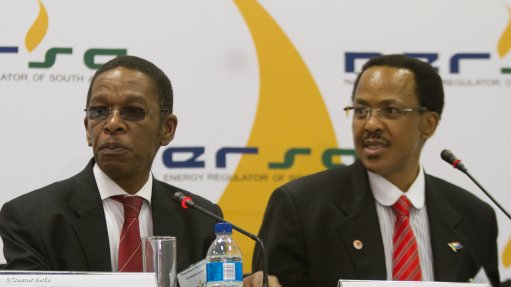
Nersa panel member Thembani Bukula and chairperson Jacob Modise
Photo by: Duane Daws
So, what did we learn from the recent rejection by the National Energy Regulator of South Africa (Nersa) of Eskom’s application for a further 2015/16 tariff hike over and above the 12.69% already granted for the year? Besides the obvious reprieve for cash-strapped South African consumers (households and businesses), there were several other spin-offs – some positive, others less so.
Firstly, in the eyes of citizens, Nersa truly established its credentials as an independent regulator – a process helped, in part, by the obvious tension between the regulatory panel and acting Eskom CEO Brian Molefe during public hearings that took place at Nasrec, near Soweto, in late June.
Secondly, Nersa has demonstrated its grasp of the legislation and regulations guiding it in exercising its mandate, which, in essence, is to balance the affordability and availability of electricity with the financial sustainability of the entities it licences, in this case Eskom. In so doing, the aspiration (hitherto not attained) is to offer price-path predictability and certainty.
This grasp of the rules of engagement, in other words the process, proved critical to the regulator’s eventual decision to set aside Eskom’s ‘selective reopener’ of the third multiyear price determination (MYPD3). Nersa was able to demonstrate, point by point, the deficiency of the application from a procedural perspective, including, crucially, its failure to provide a mechanism for how the proposed increase could be implemented in a manner that was consistent with the Municipal Finance Management Act.
There is also bad news, though.
Firstly, there are now even more questions about the competence of Eskom’s board and managers. How could such a deficient application be allowed, even when it risked undermining not only the regulatory framework but also the already tarnished reputation of the utility?
The worst-case scenario is that the incompetent submission can be put down to a loss of expertise in the utility itself. Alternatively, and almost as worrying, it could be that the electricity war room was behind the application. Eskom definitely canvassed its submission with the war room. Surely, better guidance should have been provided.
The other important piece of news – good for Eskom, less so for consumers – is that the issue is far from resolved.
Nersa remains open to receiving an application for adjustments allowed for in the MYPD methodology, using the regulatory clearing account (RCA) instrument, or to receiving a new application for the period April 1, 2016, to March 31, 2019, with indicative projections for April 1, 2019, to March 31, 2021.
There is little to no doubt that Eskom, which continues to argue that, despite successive above-inflation hikes, electricity tariffs are not cost reflective, will be considering its next move. By all accounts, both RCA and full reopener applications are at an advanced stage of drafting.
Should Eskom want the adjustment by April 1, 2016, which represents the start of the new tariff year, the regulator will require a submission six months prior to that date to enable it to conduct the assessment and consultations necessary for a determination. Therefore, South Africans should expect Eskom to make its move by no later than October, but possibly as early as this month.